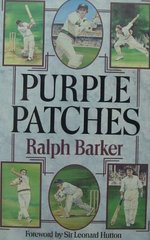Purple Patches
David Taylor |Published: 1987
Pages: 288
Author: Barker, Ralph
Publisher: William Collins
Rating: 4 stars

The late writer Ralph Barker, who died two years ago aged 93, wrote his first book on cricket, Ten Great Innings, in 1964 – this was his sixth. I’d heard of the book before picking up a copy in a local second-hand shop but I hadn’t realised it was more than 25 years old – my copy is in pristine condition. With a foreword by Sir Leonard Hutton, this tells the stories of eleven players (a number chosen, it appears, to make up a team, which the author does at the beginning) who had, at some point on their careers, an inspired run of form.
The ‘purple patches’ concept is, however, interpreted quite widely. In some cases it is a single match (Jim Laker at Old Trafford, 1956; Bob Massie, Lord’s, 1972); in some a Test series (Denis Lindsay, South Africa v Australia, 1966-67, the one that was probably least familiar to me); and in others a whole tour or season (Bill Johnston, Australia in England, 1953; Arthur Booth, Yorkshire, 1946). With each case study running to about 25 pages there is a good deal of background in each instance, so we learn about David Steele’s cricketing family, and Massie’s three seasons of league cricket in Scotland. Then we are taken, in great detail, through the player’s extraordinary run, match by match, innings by innings. The shorter the time period in question the greater is the scope for detailed examination, so, for instance, with Massie’s match we get an account of each of his 16 wickets.
Barker’s style, which was praised in previous books, is to take the reader ‘out into the middle and into the high drama of big cricket’ as Sir Leonard puts it. He does this particularly well with David Steele, recreating his walk to the middle for his first Test innings, having first lost his way of course, and his initial sparring with Lillee and Thomson. It helped no doubt that a number of his subjects were alive at the time of publication – although Bill Ponsford, an ‘essentially reticent man’ could not be induced to discuss his achievements – and there is an extensive list of credits acknowledging those who helped with the groundwork. Bill Johnston, though, seems a little out of place in this company. A fine left-arm bowler with no great pretensions to batsmanship, it was a freakish set of circumstances that saw him average over 100 in the summer of 1953 – he was, of course, dismissed only once, in 17 innings. It’s an amusing tale and well told but it’s hardly on a par with Ponsford’s 1000 runs in 16 days, or David Hookes’ run of hundreds which saw him force his way into the side for the Centenary Test.
In addition to the background of each case Barker also tries to explain the reasons for that player’s sudden success, and why, in many cases, he was unable to repeat it. Few had a more sudden and drastic fall than Massie, who played just two more Tests after returning from England. We also get a brief account of how the rest of the player’s career, and life after cricket, panned out. The writer’s enormous enthusiasm and affection for the game comes across in every chapter, and a highly enjoyable and thought-provoking read is the result.






Leave a comment